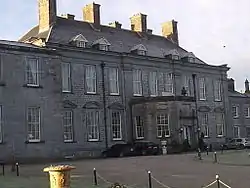William Flower, 1st Baron Castle Durrow PC (Ire) (11 March 1685 – 29 April 1746)[1] was an Anglo-Irish peer and politician.
Political career
He sat as Member of Parliament (MP) for County Kilkenny from 1715 to 1727.[2] Subsequently, he represented Portarlington until 1733,[2] when he was raised to the peerage as "Baron Castle Durrow, of Castle Durrow in the County of Kilkenny".[3] (At the time the manor of Durrow was an exclave of County Kilkenny; in 1842 it was transferred to Queen's County, later known as Laois.)
Flower was made High Sheriff of County Kilkenny in 1731,[1] and was invested to the Privy Council of Ireland in 1735.[4]
He owned a substantial property at Abercynrig in Brecon. He inherited it from his stepmother, the Welsh heiress Dorothea Jeffreys. She was the only daughter of Colonel John Jeffreys, first Master of the Royal Hospital Kilmainham, and widow of Arthur Turner (died 1684), judge of the Court of Common Pleas (Ireland). He built Castle Durrow, Durrow, County Laois, as his principal Irish residence: the family remained there until 1922.
Jonathan Swift praised him as "a gentleman of very good sense and wit".

Family
He was the only son of Thomas Flower of Finglas and his first wife Mary Temple, daughter of Sir John Temple, Speaker of the Irish House of Commons, and Jane Yarner. His paternal grandparents were Sir William Flower, MP and Privy Councillor, and Frances Weldon.[5] Flower was educated at Christ Church, Oxford. He succeeded to his father's estates in 1700.[5]
In 1717, Flower married Edith Caulfeild, daughter of Hon. Toby Caulfeild, a son of the 1st Viscount Charlemont and Rebecca Walsh.[6] They had two daughters and two sons. His daughter Rebecca, married James Agar, a prominent County Kilkenny politician, and was the mother of six children, including George Agar, 1st Baron Callan.[3]
Flower died in 1746 aged 61 and was buried at Finglas in County Dublin.[5] His only surviving son Henry succeeded to the barony.[7] and became the first Viscount Ashbrook in 1751.
References
- 1 2 "Leigh Rayment - Peerage". Archived from the original on 8 June 2008. Retrieved 24 March 2009.
{{cite web}}: CS1 maint: unfit URL (link) - 1 2 "Leigh Rayment - Irish House of Commons 1692-1800". Archived from the original on 7 June 2008. Retrieved 24 March 2009.
{{cite web}}: CS1 maint: unfit URL (link) - 1 2 Burke, John (1832). A Genealogical and Heraldic History of the Peerage and Baronetage of the British Empire. Vol. I (4th ed.). London: Henry Colburn and Richard Bentley. p. 47.
- ↑ "Leigh Rayment - Privy Council of Ireland". Archived from the original on 7 June 2008. Retrieved 27 March 2009.
{{cite web}}: CS1 maint: unfit URL (link) - 1 2 3 "ThePeerage - William Flower, 1st Baron Castle Durrow". Retrieved 24 March 2009.
- ↑ Lodge, Edmund (1838). The Genealogy of the Existing British Peerage (6th ed.). London: Saunder and Otley. p. 25.
- ↑ Debrett, John (1831). Debrett's Peerage of the United Kingdom of Great Britain and Ireland. Vol. II (19th ed.). London: G. Woodfall. p. 853.